How to Create an A.I: Step-by-Step for Marketing Managers
Learn how to create an A.I. for marketing with step-by-step guidance and key strategies.

Key Highlights:
- AI agents are software applications that can automate tasks and make decisions based on objectives, particularly useful in marketing.
- Key marketing tasks that AI can automate include customer segmentation, content generation, and campaign optimization.
- The SwarmZero framework offers a marketplace for creating and monetizing AI solutions, enhancing web search capabilities through the Tavily API.
- To set up an AI development environment, choose Python, instal necessary IDEs and libraries, and create a virtual environment.
- Building an AI agent involves defining its purpose, gathering quality data, creating the assistant, training it, and testing its functionality.
- Deployment requires selecting a platform, integrating with marketing tools, monitoring performance, and gathering feedback for continuous improvement.
- Rigorous testing, including A/B testing and user interaction analysis, is crucial for optimising AI agent performance.
- Advanced features like API integration, machine learning models, and real-time analytics can enhance AI capabilities.
- Regular performance reviews, updating information sources, and refining algorithms are essential for maintaining an effective AI agent.
- AI systems can be leveraged for tailored content development, automated client interaction, predictive analytics, campaign optimization, and feedback analysis.
Introduction
Creating an AI system is no longer confined to tech giants; it has emerged as a crucial skill for marketing managers eager to leverage automation and data-driven decision-making. This guide provides a comprehensive, step-by-step approach to developing AI agents tailored to marketing needs. It empowers professionals to streamline operations, optimise campaigns, and enhance customer engagement.
As the landscape of AI evolves rapidly, marketers must consider:
- How can they ensure their strategies remain effective and relevant in an increasingly competitive environment?
Understand the Basics of AI Agents
AI systems are independent software applications designed to execute tasks and make decisions based on defined objectives. They possess the ability to analyse data, learn from interactions, and adapt their actions accordingly. In the realm of marketing, AI systems can automate repetitive tasks such as:
- Customer segmentation
- Content generation
- Campaign optimization
The SwarmZero framework serves as a comprehensive AI marketplace, teaching users how to create an A.I, as well as monetize and automate business solutions effectively. A significant application is the AI-powered web search tool that leverages the Tavily API, enhancing search capabilities through advanced AI processing.
Familiarising yourself with the categories of AI systems—reactive systems, learning systems, and goal-oriented systems—will aid in selecting the most suitable option for your promotional needs. For instance, a learning entity can improve its effectiveness over time by analysing previous campaign data, making it ideal for dynamic marketing environments.
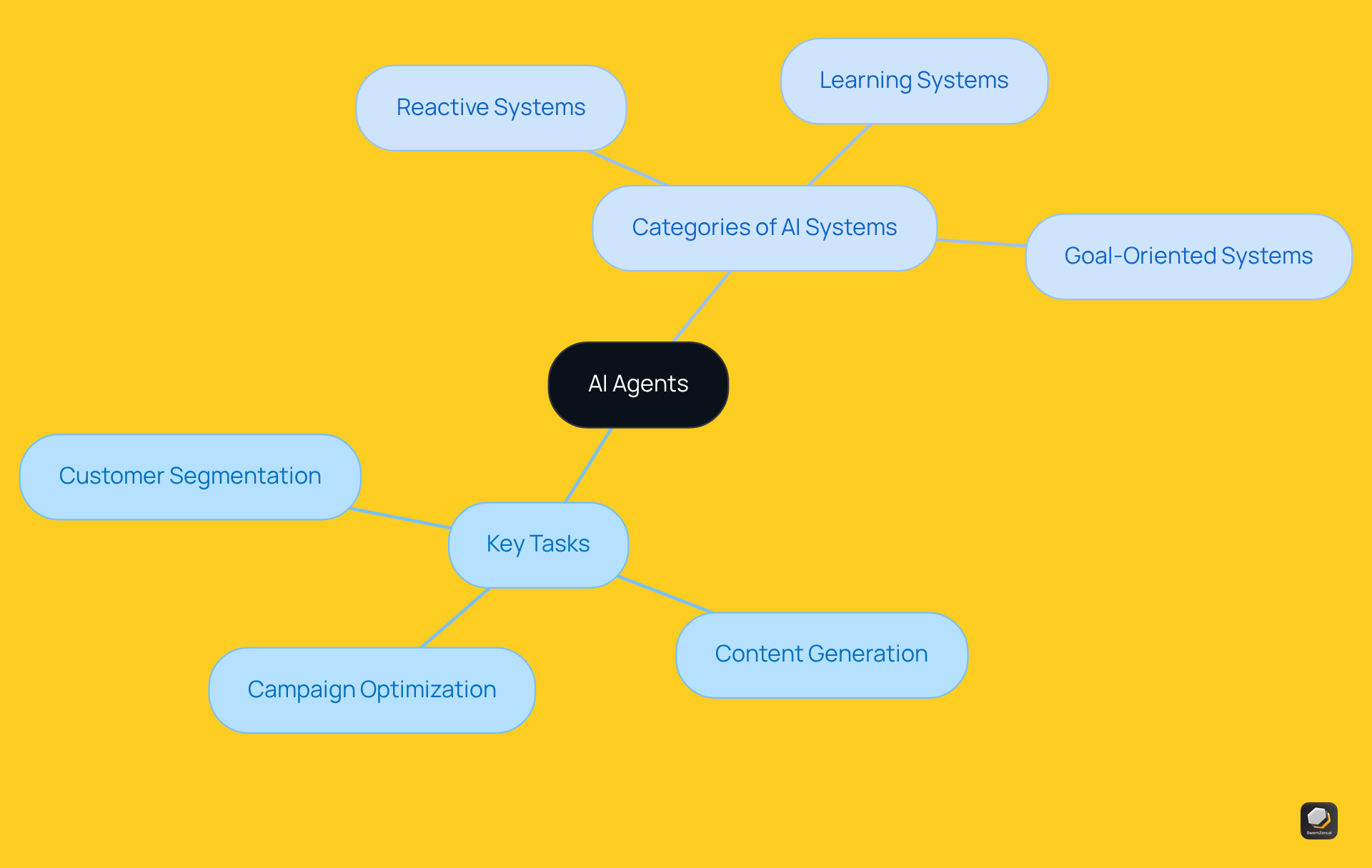
Set Up Your Development Environment
Establishing a robust development environment is essential when learning how to create an AI system. Follow these steps:
-
Choose a Programming Language: Python is highly recommended for AI development due to its extensive libraries and community support, making it ideal for both beginners and experienced developers.
-
Install Necessary Software: Download and install an Integrated Development Environment (IDE) such as PyCharm or Visual Studio Code. These tools offer features that simplify coding, debugging, and project management, enhancing overall productivity.
-
Set Up Libraries: Install essential libraries like TensorFlow, Keras, or PyTorch to enable machine learning capabilities. Use pip to install these libraries via the command line:
pip install tensorflow keras torch -
Create a Virtual Environment: This practice helps manage dependencies specific to your project, ensuring a clean workspace. Use the following commands:
python -m venv myenv source myenv/bin/activate # On Windows use `myenv\Scripts\activate` -
Test Your Setup: Write a simple script to verify that your environment is functioning correctly. For instance, print a message to confirm your setup:
print('Development environment is set up!') -
Next Steps for Enhancing Your AI Agent: After setting up the basic bot, consider adding custom trading strategies, implementing additional data sources, creating automated trading features, adding more blockchain networks, and enhancing the AI analysis capabilities. These steps will help you leverage SwarmZero's platform effectively.
By following these steps, you will learn how to create an AI system with a strong base, utilizing Python's features to improve your projects efficiently.
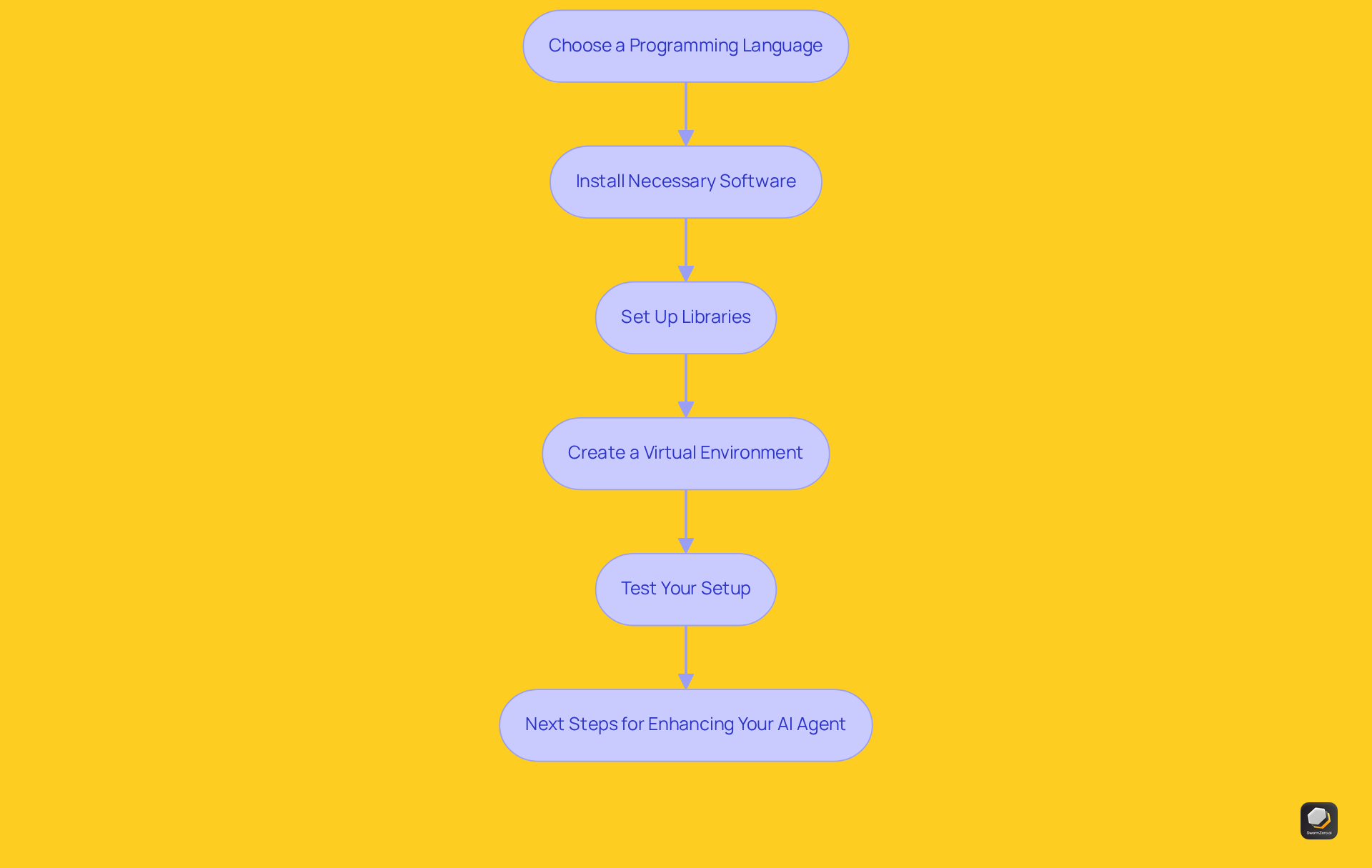
Build Your First AI Agent
To build your first AI agent, follow these essential steps:
-
Define the Purpose: Clearly outline the specific task your AI system will perform. For instance, it could focus on creating personalised email campaigns tailored to client preferences.
-
Gather Information: Collect high-quality, relevant information that your agent will utilise for learning. This may include customer demographics, historical campaign performance, and engagement metrics. The significance of information quality cannot be overstated; poor information can lead to inaccurate AI behaviour, a substantial concern in the industry.
-
Create the Assistant: Utilise a framework such as Rasa or Dialogflow to construct your assistant. Here’s a simple example using Python:
class EmailAgent: def __init__(self, data): self.data = data def generate_email(self): # Logic to generate email based on data return 'Your personalised email content' -
Train the Representative: Provide your representative with the collected data to educate it efficiently. This process entails offering examples that enable the system to learn patterns and enhance its performance.
-
Test the Agent: Conduct thorough testing to ensure the agent operates as intended. Monitor its performance and make necessary adjustments to parameters, retraining as needed.
Successful case studies, such as Spotify's AI for fraud detection, demonstrate how effective data gathering and quality can enhance AI capabilities. Marketing professionals emphasise that 74% of business owners expect AI to assist in generating customer responses, highlighting the growing reliance on AI tools for efficiency and engagement. By following these steps, you will understand how to create an AI system that significantly enhances your marketing efforts.
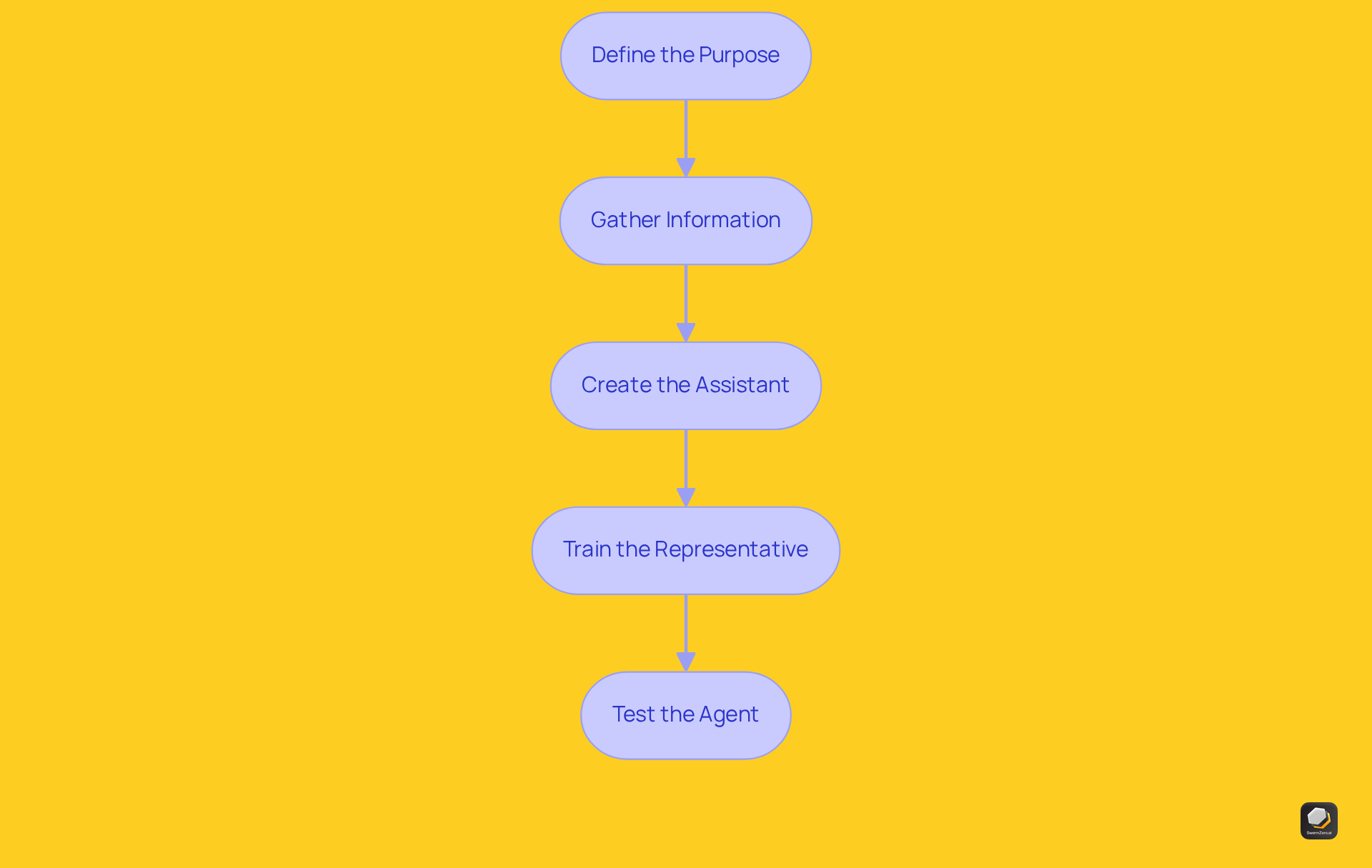
Deploy and Integrate Your AI Agent
Once your AI agent is built and tested, it’s time to deploy it effectively.
-
Choose a Deployment Platform: Select a platform that supports your AI entity, such as AWS, Google Cloud, or Azure. This decision is crucial for ensuring optimal performance.
-
Integrate with Marketing Tools: Connect your AI assistant to existing marketing tools like CRM systems (e.g., Salesforce) or email marketing platforms (e.g., Mailchimp). This integration enables your representative to access client information and automate tasks efficiently, streamlining operations.
-
Monitor Performance: After deployment, continuously observe the system’s performance. Utilise analytics tools to track key metrics such as engagement rates and conversion rates, allowing for data-driven decision-making.
-
Revise and Enhance: Using performance information, implement necessary changes to increase the effectiveness of the representative. This could involve retraining the representative with new data or adjusting its algorithms to better meet business needs.
-
Gather Feedback: Collect input from users and stakeholders to refine the system further and ensure it aligns with business objectives. This feedback loop is essential for ongoing improvement.
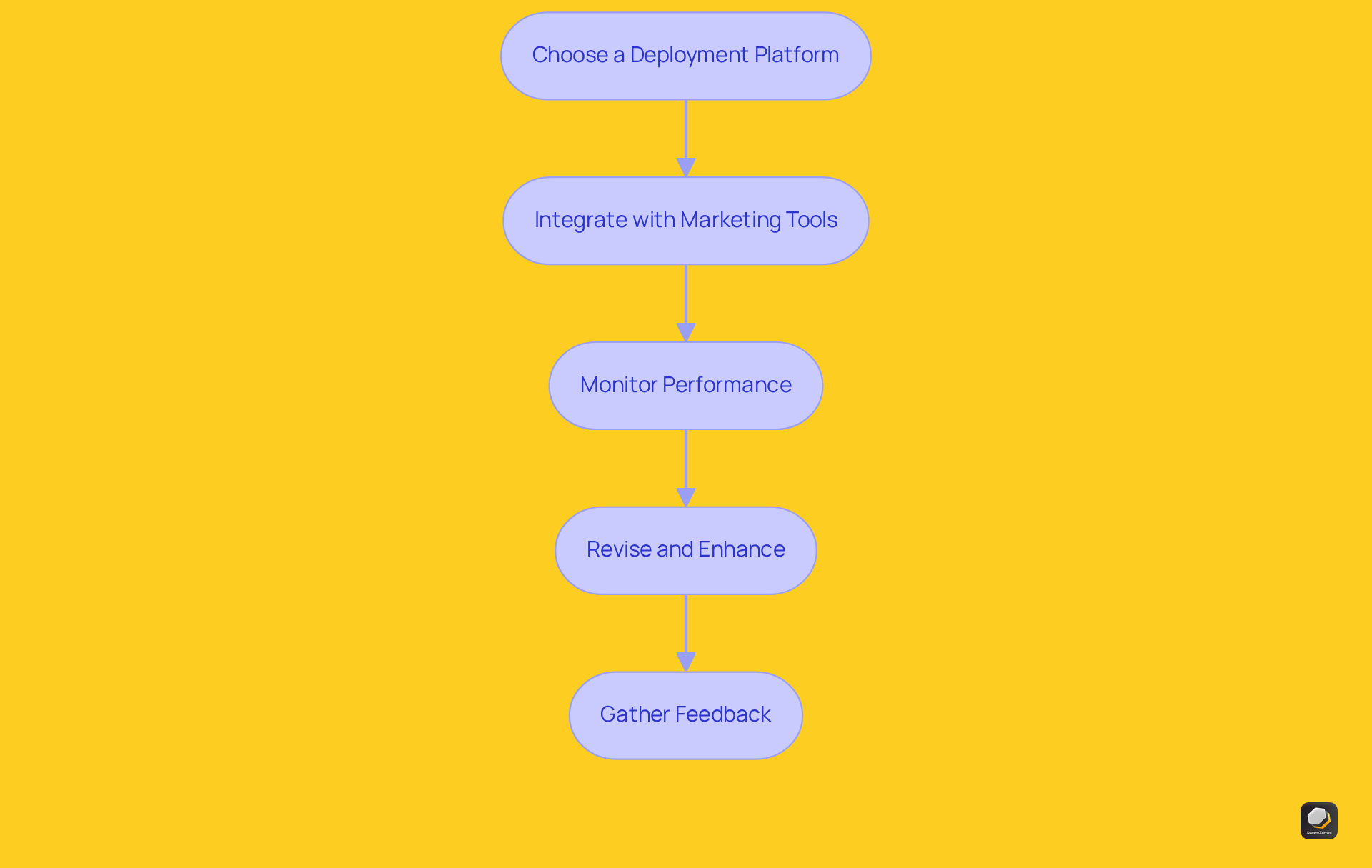
Test and Optimize Your AI Agent
To ensure your AI agent performs optimally after deployment, rigorous testing and optimisation are crucial.
-
Conduct A/B Testing: Implement A/B tests to evaluate different versions of your AI assistant. This method allows you to pinpoint which configurations lead to superior outcomes. Notably, companies that embrace A/B testing can see significant improvements; for instance, Dell reported a 300% increase in conversion rates through strategic testing. Furthermore, 59% of firms conduct A/B testing in their email marketing campaigns, highlighting its widespread application across platforms.
-
Analyse User Interactions: Closely monitor user interactions with your AI assistant. Utilise analytics tools to gather information on engagement levels and user satisfaction. Research indicates that 77% of firms globally conduct A/B testing on their websites, underscoring the importance of understanding user behaviour in optimising AI performance.
-
Adjust Algorithms: Use the insights gained from user interaction analysis to refine your AI system's algorithms. This may involve retraining the model with fresh data or fine-tuning parameters to enhance accuracy. Continuous improvement is essential, as 63% of companies find A/B testing easy to implement, facilitating ongoing optimisation efforts. For example, Hubstaff achieved a 49% increase in sign-ups through their commitment to a testing culture.
-
Implement Feedback Loops: Create avenues for users to share their thoughts on the system’s performance. This feedback is invaluable for making iterative improvements, ensuring that the AI system evolves in response to user needs. A structured approach to collecting and analysing feedback can significantly enhance this process.
-
Stay Updated with Trends: Remain informed about the latest developments in AI and marketing. Keeping pace with industry trends is essential for preserving your representative's competitiveness and effectiveness in a rapidly evolving landscape. As the market for A/B testing is projected to reach USD 850.2 million by 2024, with a CAGR of 14.00% from 2024 to 2031, leveraging these insights can significantly enhance your AI strategies.
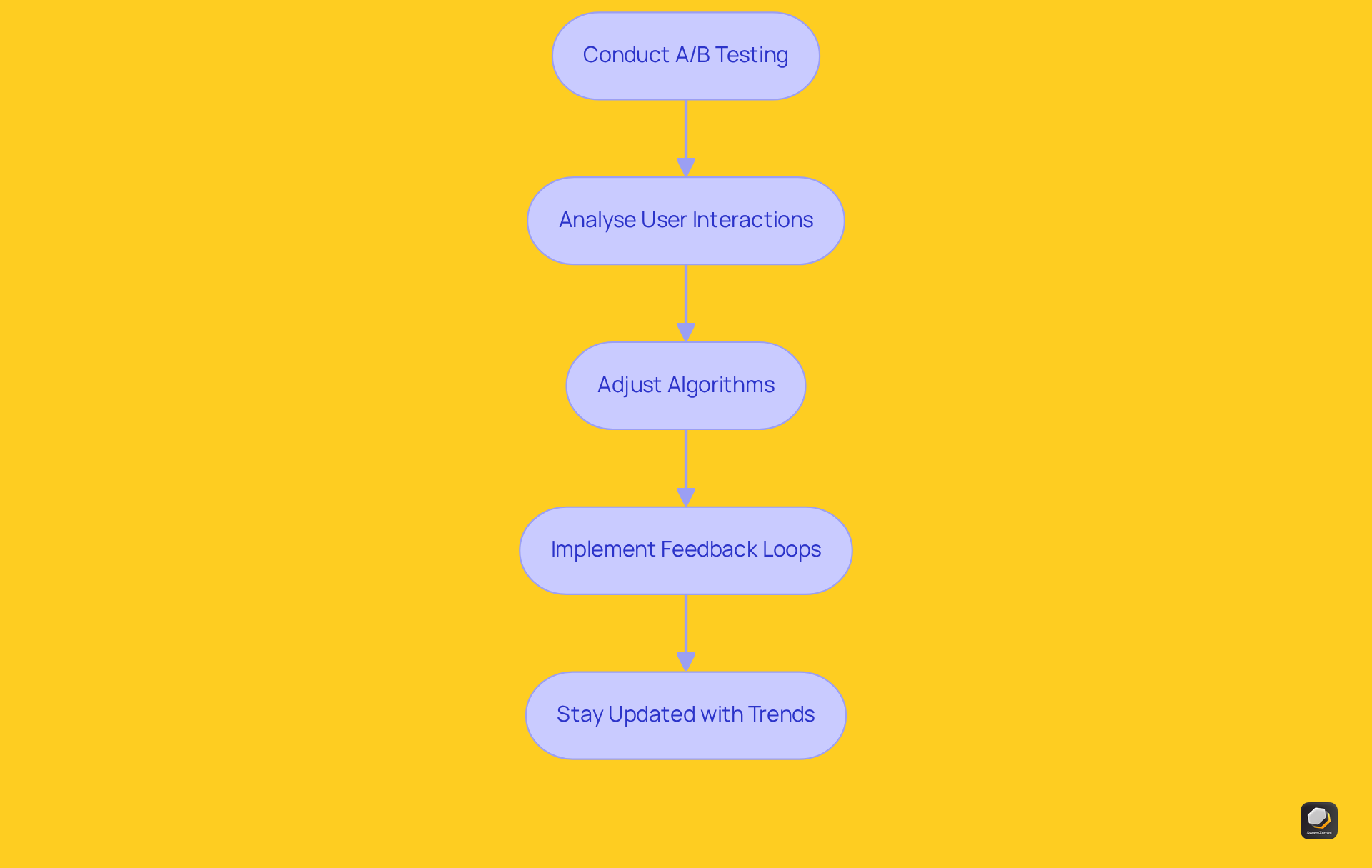
Explore Advanced Features and Integrations
To enhance the capabilities of your AI agent, it is essential to explore advanced features and integrations:
- Integrate with APIs: Connecting your AI system with third-party APIs significantly expands its functionality. For instance, linking with social media APIs allows your representative to automate posting updates, thereby enhancing your promotional efforts.
- Utilise Machine Learning Models: By integrating multiple machine learning models into your system, you can bolster its decision-making capabilities. This integration enhances personalization and targeting in promotional campaigns, enabling more effective customer engagement.
- Organise Representatives into Swarms: For intricate promotional tasks, organising several representatives into swarms proves advantageous. This cooperative approach facilitates collaboration on tasks, resulting in heightened efficiency and effectiveness in implementing promotional strategies.
- Implement Real-Time Analytics: Utilising real-time analytics to monitor your representative’s performance empowers you to make adjustments on the fly. This agility ensures that your marketing strategies remain adaptable to evolving conditions and client needs.
- Explore Cross-Platform Capabilities: Ensure your AI system operates seamlessly across various platforms and devices. This maximises its reach and impact, allowing you to engage with customers wherever they are.
By leveraging these advanced features, you can significantly enhance your understanding of how to create an AI representative in marketing for improved performance and effectiveness.
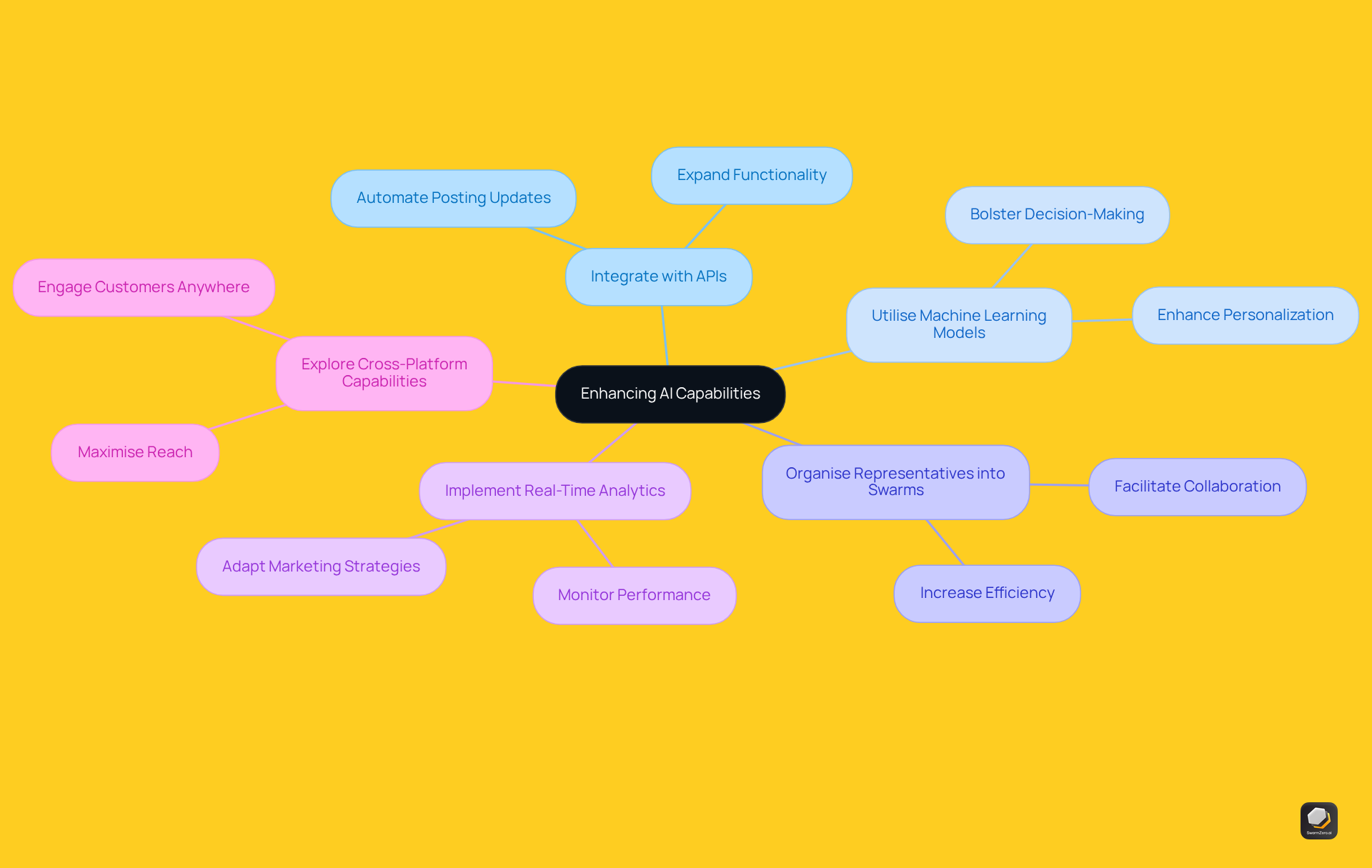
Monitor and Maintain Your AI Agent
To ensure your AI agent remains effective, implement a comprehensive monitoring and maintenance plan:
-
Regular Performance Reviews: Schedule periodic assessments to evaluate the agent’s performance against key performance indicators (KPIs). This practise is crucial for identifying areas of enhancement and ensuring alignment with how to create an a.i. Setting measurable goals can significantly improve marketing effectiveness, such as increasing enterprise lead quality by 25%.
-
Update Information Sources: Maintain the details your agent depends on as up-to-date and pertinent. Frequent updates to information sources are essential to capture changes in customer behaviour and market trends, which can greatly influence how to create an a.i successfully. Regular assessments of information are vital for ensuring AI tools have clean, reliable data.
-
Refine Algorithms: As new data becomes available, refine the algorithms to enhance accuracy and effectiveness. This may involve retraining the model or adjusting parameters to better align with evolving market conditions.
-
Conduct User Training: Provide ongoing training for users interacting with the AI system. Ensuring that team members comprehend its features and restrictions is crucial for optimising the system's potential and incorporating it efficiently into promotional workflows. As Jonathan Costello, Senior Content Strategist, states, 'AI marketing refers to how to create an a.i that uses artificial intelligence tools to make marketing decisions and automate campaigns.'
-
Document Changes: Maintain detailed records of any modifications made to the AI system, including updates to algorithms, data sources, and performance metrics. This documentation is invaluable for troubleshooting issues and guiding future enhancements, ensuring a robust and adaptable AI solution. For instance, Starbucks enhanced its rewards programme by using AI to analyse customer purchase patterns, leading to more personalised offers and increased customer spending and engagement.
By adhering to these best practises, managers in promotion can ensure their AI assistants remain efficient and aligned with their strategic objectives.
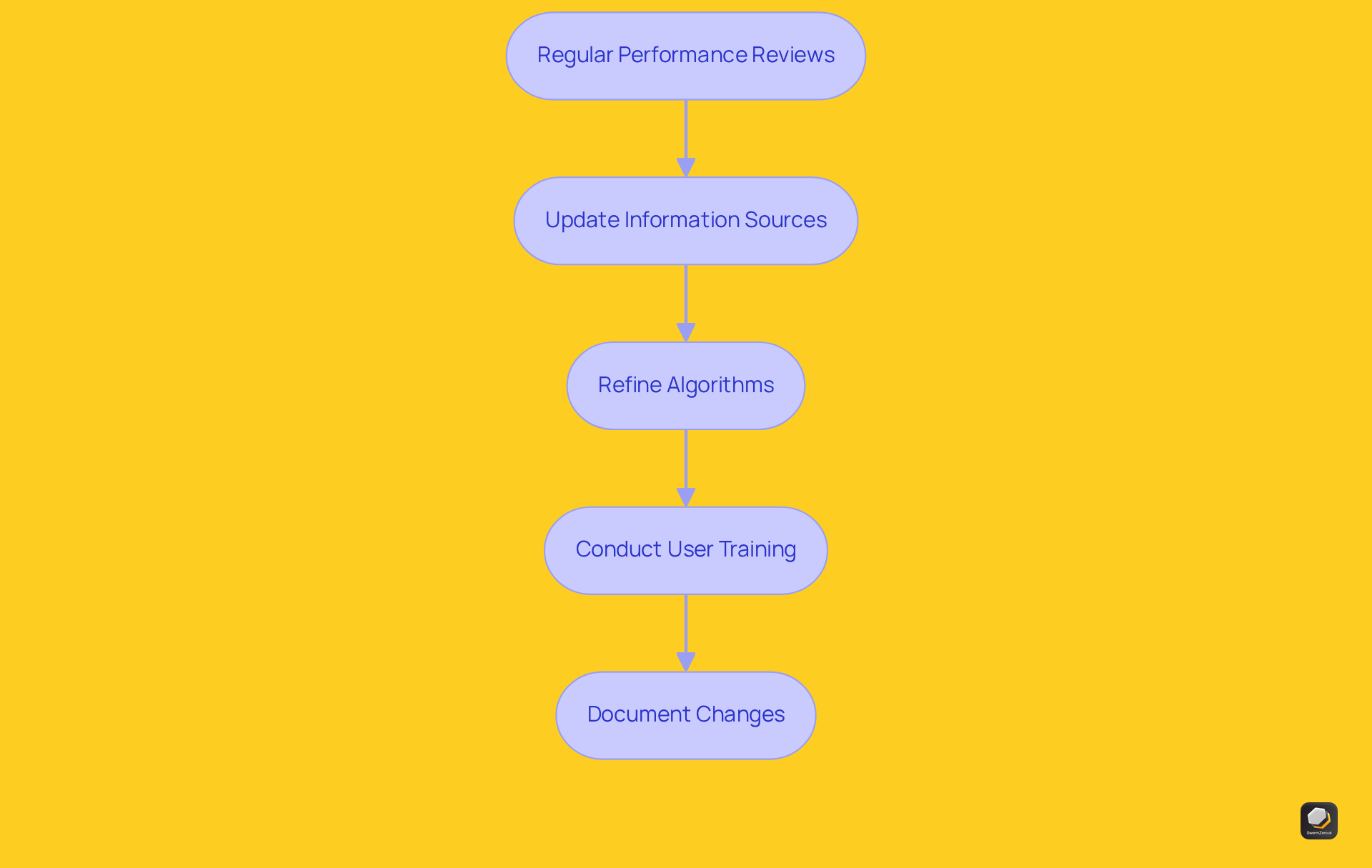
Leverage AI Agents for Marketing Campaigns
AI systems serve as powerful tools in executing marketing campaigns. Here’s how to leverage them effectively:
- Tailored Content Development: Utilise AI systems built on the SwarmZero framework to create customised content for email campaigns, social media posts, and landing pages tailored to user information and preferences.
- Automated Client Interaction: Implement chatbots as AI representatives using the Tavily API to engage with clients in real-time, addressing inquiries and providing support around the clock. The Tavily API enhances these interactions by offering advanced search capabilities for more accurate and relevant responses.
- Predictive Analytics: Leverage AI systems to analyse historical data and predict future consumer behaviours, enabling targeted promotional strategies.
- Campaign Optimization: Utilise AI systems to monitor campaign performance in real-time, making necessary adjustments to enhance results based on engagement metrics. The SwarmZero framework’s enhanced search capabilities can be utilised to identify trends and insights more effectively.
- Feedback Analysis: Employ AI agents to analyse customer feedback and sentiment from various channels, refining marketing strategies and improving customer satisfaction.
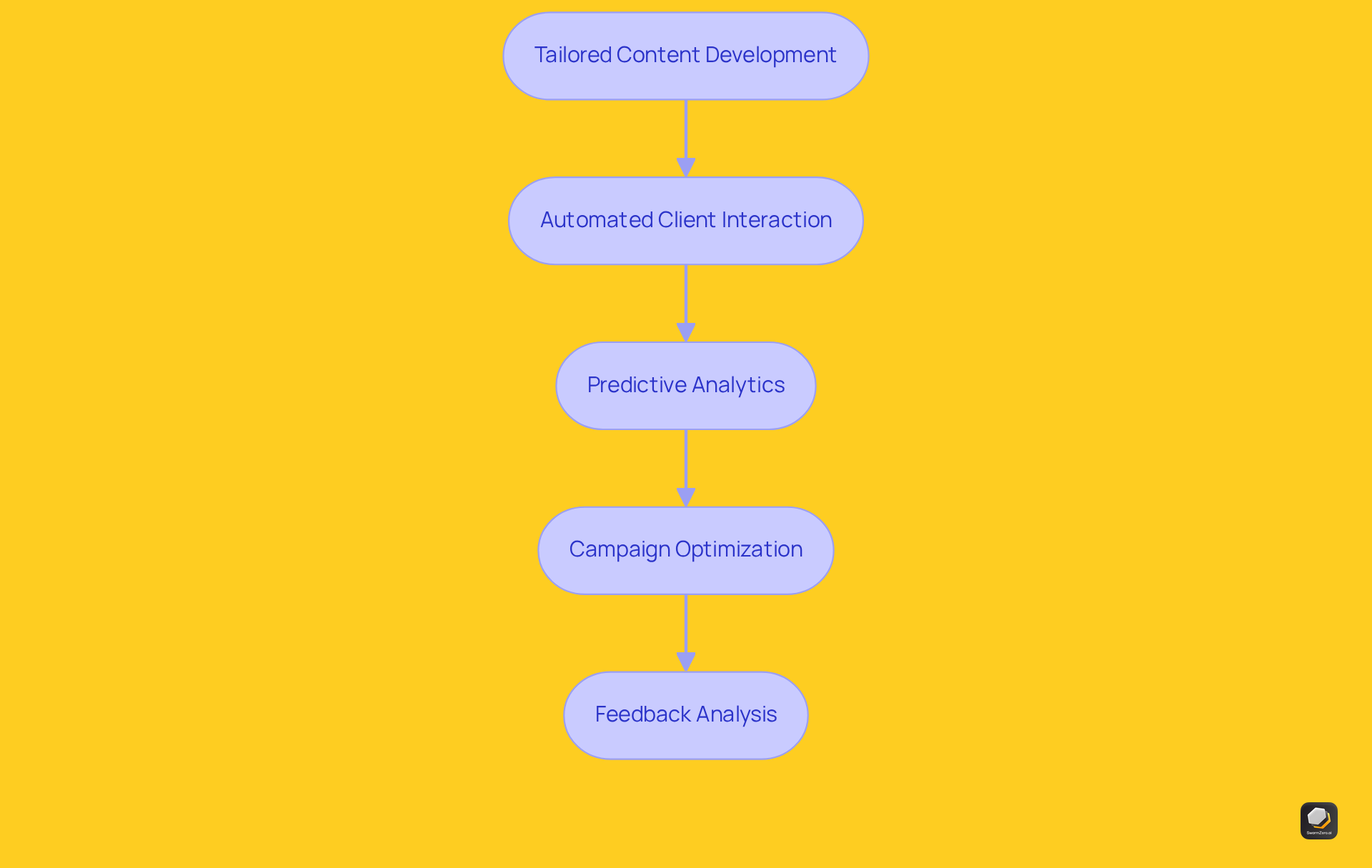
Conclusion
Creating an AI system tailored for marketing managers requires a multifaceted approach that includes understanding AI fundamentals, setting up a development environment, building and deploying the AI agent, and continuously optimising its performance. This comprehensive guide outlines the necessary steps and insights to effectively leverage AI in marketing strategies, ensuring marketing professionals can enhance their campaigns and automate processes efficiently.
Key arguments highlighted throughout the article emphasise the importance of:
- Selecting the right AI category based on specific marketing needs
- Gathering high-quality data for training
- Integrating advanced features and real-time analytics
Moreover, the significance of ongoing monitoring and maintenance of the AI agent cannot be overstated, as it ensures that the system remains effective and aligned with evolving marketing objectives.
In a rapidly changing marketing landscape, the implementation of AI agents is not merely a trend but a crucial strategy for success. By embracing these technologies, marketing managers can:
- Improve customer engagement
- Personalise campaigns
- Optimise their overall marketing efforts
Taking the first step toward creating an AI agent can significantly elevate a marketing strategy, making it essential for professionals to stay informed and proactive in adopting AI solutions. Engage with the resources available and embark on the journey of transforming marketing practises through the power of artificial intelligence.
Frequently Asked Questions
What are AI agents and their main functions?
AI agents are independent software applications designed to execute tasks and make decisions based on defined objectives. They can analyse data, learn from interactions, and adapt their actions. In marketing, they automate tasks such as customer segmentation, content generation, and campaign optimisation.
What is the SwarmZero framework?
The SwarmZero framework is a comprehensive AI marketplace that teaches users how to create, monetise, and automate business solutions using AI. It includes an AI-powered web search tool that leverages the Tavily API for enhanced search capabilities.
What categories of AI systems should I be familiar with?
Familiarising yourself with three categories of AI systems—reactive systems, learning systems, and goal-oriented systems—will help you choose the most suitable option for your promotional needs. Learning systems, for example, can improve over time by analysing previous campaign data, making them ideal for dynamic marketing environments.
What programming language is recommended for AI development?
Python is highly recommended for AI development due to its extensive libraries and strong community support, making it suitable for both beginners and experienced developers.
What software should I instal for AI development?
You should download and instal an Integrated Development Environment (IDE) such as PyCharm or Visual Studio Code to simplify coding, debugging, and project management.
Which libraries are essential for AI development in Python?
Essential libraries for AI development include TensorFlow, Keras, and PyTorch. You can instal these libraries using pip via the command line.
How can I create a virtual environment for my AI project?
To create a virtual environment, use the following commands:
python -m venv myenvsource myenv/bin/activate(On Windows, usemyenv\Scripts\activate).
How can I test if my development environment is set up correctly?
You can write a simple script to verify your setup. For example, use the following code to print a confirmation message:
print('Development environment is set up!')
What are the next steps after setting up a basic AI agent?
After setting up the basic bot, you can enhance it by adding custom trading strategies, implementing additional data sources, creating automated trading features, adding more blockchain networks, and improving AI analysis capabilities.
List of Sources
- Set Up Your Development Environment
- EliteBrains matches elite developers with tech companies. (https://elitebrains.com/blog/aI-generated-code-statistics-2025)
- Top AI Programming Languages You Should Know in 2025 (https://radixweb.com/blog/ai-programming-languages)
- Build Your First AI Agent
- 50 NEW Artificial Intelligence Statistics (June 2025) (https://explodingtopics.com/blog/ai-statistics)
- 131 AI Statistics and Trends for (2024) | National University (https://nu.edu/blog/ai-statistics-trends)
- AI Training Dataset Market (https://market.us/report/ai-training-dataset-market)
- AI Statistics 2024 · AIPRM (https://aiprm.com/ai-statistics)
- 100+ AI Statistics Shaping Business in 2025 - Vena (https://venasolutions.com/blog/ai-statistics)
- Test and Optimize Your AI Agent
- 28 A/B Testing Statistics for Informed Decision-Making (https://mailmodo.com/guides/ab-testing-statistics)
- 30 Key A/B Testing Statistics: A Comprehensive Guide | VWO (https://vwo.com/blog/ab-testing-statistics)
- Explore Advanced Features and Integrations
- AI Agents Statistics: Usage Insights And Market Trends (2025) | SellersCommerce (https://sellerscommerce.com/blog/ai-agents-statistics)
- AI Agent Statistics for 2025: Adoption, ROI, Performance & More (https://plivo.com/blog/ai-agents-top-statistics)
- AI Agents Statistics: Usage And Market Insights (https://litslink.com/blog/ai-agent-statistics)
- 25 AI Agent in Marketing Statistics | Datagrid (https://datagrid.com/blog/ai-agent-marketing-statistics)
- 80+ AI Agent Usage Stats for 2025 | Zebracat (https://zebracat.ai/post/ai-agent-usage-statistics)
- Monitor and Maintain Your AI Agent
- How to Leverage AI in Marketing: Strategies and Best Practices (https://demandbase.com/blog/how-to-leverage-ai-in-marketing-strategies-and-best-practices)




